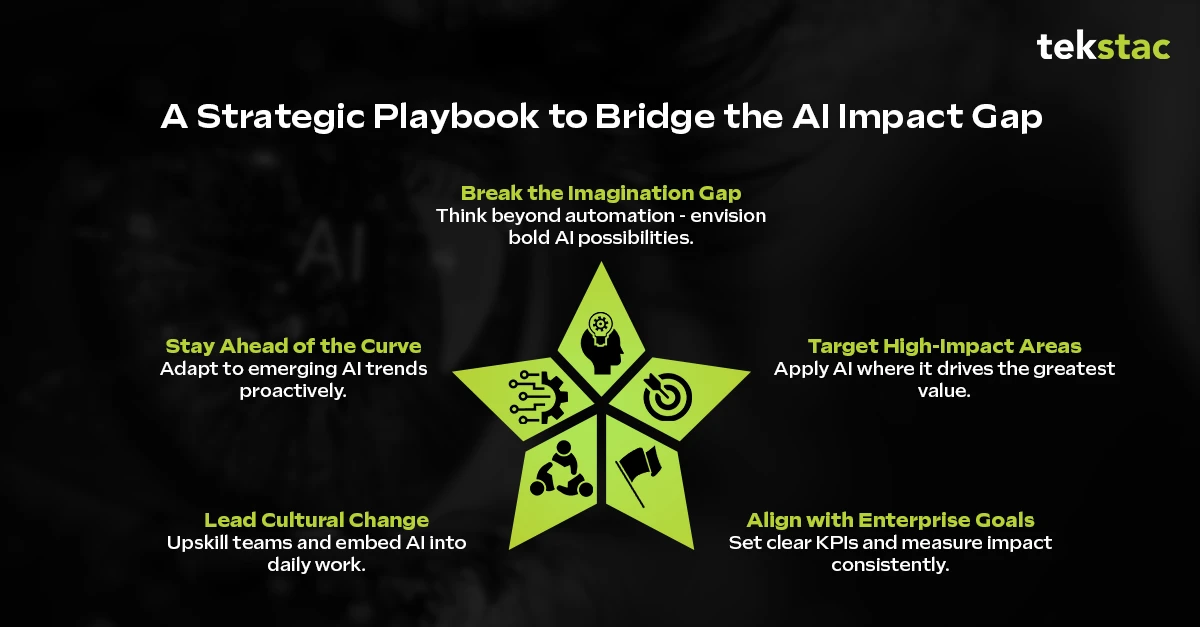Closing the AI Impact Gap: From Potential to Profit
May 7, 2025

Based on insights from the BCG AI Radar 2025 report.
The world is racing toward an AI-powered future, with businesses investing heavily in artificial intelligence. Yet, despite grand ambitions, many companies struggle to turn AI potential into real business impact. The latest BCG AI Radar 2025 report reveals a stark contrast between AI investments and actual value realization. With AI spending projected to surge by 60% in the next three years, the question remains: How can organizations bridge the AI impact gap?
The AI Investment Boom: Are Companies Seeing Returns?
One in three companies globally is planning to invest over $25 million in AI in 2025. While AI and GenAI rank among the top three strategic priorities for 75% of executives, only 25% are witnessing significant returns. The challenge lies not in the technology itself but in how it is deployed, scaled, and integrated into everyday business operations.
What Separates AI Leaders from the Rest?
Leading organizations approach AI differently. Instead of scattering their investments across multiple pilots with diluted impact, they focus on three strategic plays:
- Embedding AI into Everyday Workflows – By deploying AI in routine tasks, businesses unlock 10-20% productivity gains.
- Reshaping Critical Functions – AI-driven process enhancements boost efficiency and effectiveness by 30-50%.
- Inventing New Products and Services – This strategy drives innovation and long-term competitive advantage.
While most companies allocate only 27% of their AI budget to high-impact initiatives, leading firms dedicate over 80% to reshaping functions and driving innovation.
The Data Dilemma: Tracking AI’s True Value
Surprisingly, 60% of companies fail to track financial KPIs linked to AI investments. Without clear performance metrics, organizations risk losing sight of AI’s bottom-line impact. Leading firms, on the other hand, adopt a disciplined approach, defining goals, measuring top- and bottom-line results, and continuously refining their AI strategies.
The People Factor: Why AI Success Depends on More Than Technology
AI success isn’t just about algorithms, it’s about people and processes. The best-performing companies follow the 10-20-70 principle:
- 10% of AI success comes from cutting-edge algorithms.
- 20% is driven by robust technology infrastructure.
- 70% depends on people, culture, and process transformation.
Despite the rise of AI, only 6% of companies have trained over 25% of their workforce in AI/GenAI tools. Without widespread AI upskilling, businesses will struggle to fully capitalize on their investments.
Navigating AI Risks: The Need for Stronger Governance
While AI promises efficiency and innovation, it also brings risks. The top concerns for executives include:
- Data privacy and security (66%)
- Lack of control over AI decisions (48%)
- Regulatory and compliance challenges (44%)
Cybersecurity remains a major weak spot, with 76% of executives acknowledging the need for stronger AI security measures. Companies that proactively address these risks will gain a competitive edge in trust and reliability.
The Rise of AI Agents: A New Frontier in Business Transformation
2025 marks the rise of AI agents, intelligent systems capable of learning, reasoning, and taking actions on behalf of users. While 67% of companies are exploring AI agents as part of their transformation strategy, true success lies in their thoughtful application. Leaders must avoid the hype, focus on targeted implementations, and ensure AI agents complement human capabilities rather than replace them.
Conclusion: A Strategic Playbook for AI Success
To bridge the AI impact gap, businesses must rethink their AI strategies. The most successful organizations maximize AI value by:

- Breaking through the imagination gap – Envisioning AI-driven transformation beyond incremental improvements.
- Targeting high-impact opportunities – Prioritizing core business functions that AI can enhance significantly.
- Aligning AI with enterprise goals – Setting clear KPIs and continuously tracking value creation.
- Leading cultural and organizational change – Empowering employees through AI upskilling and change management.
- Preparing for the next AI wave – Anticipating emerging AI trends and proactively adapting strategies.
The future belongs to those who can not only invest in AI but also extract real value from it. The time to act is now, before the AI impact gap widens further.





